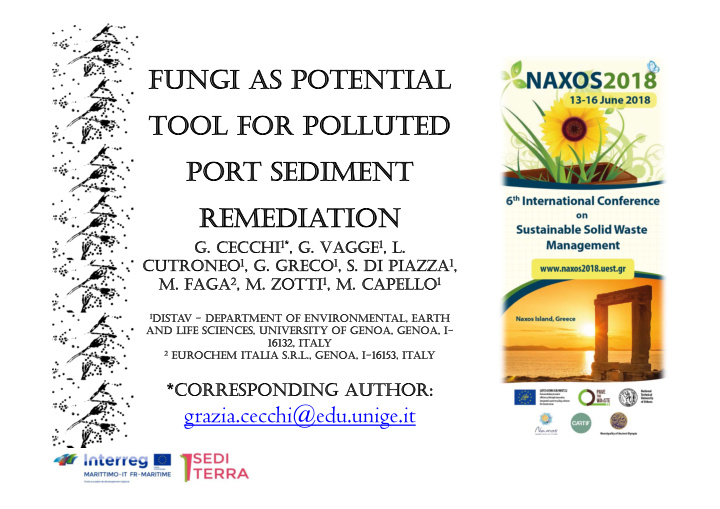



FUNGI AS POTENTIAL FUNGI AS POTENTIAL TOOL FOR POLLUTED TOOL FOR POLLUTED POR PORT SEDIMENT SEDIMENT REMEDIA REMEDIATION ION G. CECCHI G. CECCHI 1* 1* , G. , G. VAGGE VAGGE 1 , L. , L. CUTRONEO CUTRONEO 1 , G. GRECO , G. GRECO 1 , S. D , S. DI P PIAZZA AZZA 1 , , M. FAGA M. FAGA 2 , M. , M. ZOTTI ZOTTI 1 , M. , M. CAPELLO CAPELLO 1 1 DIS DISTA V - - DEP EPAR ARTMEN ENT OF ENVIR OF ENVIRONMEN ENTAL, EAR EARTH AND LIFE SCIENC AND LIFE SCIENCES, UNIVE , UNIVERSITY OF GEN SITY OF GENOA, GEN A, GENOA, I- I- 1613 16132, IT ITAL ALY 2 EUR EUROCH CHEM IT ITAL ALIA IA S.R. S.R.L., GEN GENOA, I-16153 I-16153, IT ITAL ALY *CORRESPONDING AUTHOR: *CORRESPONDING AUTHOR: grazia.cecchi@edu.unige.it
Guidelines for the sustainable treatment of dredged sediments in the Marittimo area
INTRODUCTION : CONT : CONTAMINA MINATION TION INTRODUCTION OF OF MARINE SEDIMENT MARINE SEDIMENT need of periodical dredging activities for the maintenance of the navigational depth in ports and waterways huge volumes of contaminated sediments which need to be properly handled due their load of inorganic and organic substances
INTRODUCTION : : CONT CONTAMINA AMINATION ION OF MARINE ARINE INTRODUCTION SEDIMENT SEDIMENT AND REMEDIA AND REMEDIATION ION STRA TRATEGIES EGIES THERM THERMAL L TREATM TREATMENT ENT WASHING WASHING ELECTR ELECTRON- ON- CHEMICAL CHEMICAL BIOREMEDIA BIOREMEDIATION TION SEPARATION SEPARATION
INTRODUCTION: FUNGI FUNGI INTRODUCTION: - Colonize every kind of environment - Secrete enzymes and organic acids which may interact with contaminants - Bioconcentrate, bioaccumulate, and biostabilize heavy metals
STUDY AREA : : THE GENOA POR THE GENOA PORT STUDY AREA This area represents one of the most industrialized zones in North- Western Italy and extends for 10 km. The waters inside the Port are rich in nutrients, fecal coliform, chlorophyll α . The bottom sediments are rich in metals, organic materials and PAHs due to the input of sewage and industrial discharges.
ND METHODS: SAMPLING SAMPLING MA MATERIALS TERIALS AND METHODS: AND SEDIMENT CHARACTERIZA AND SEDIMENT CHARACTERIZATION TION - heavy metals - organic inorganic fraction - grain-size - fungal characterization
ND METHODS : PILOT : PILOT MA MATERIALS TERIALS AND METHODS MYCOLOGICAL MYCOLOGICAL ACTIVITY CTIVITY
RESUL RESULTS & DISCUSSION DISCUSSION Aspergillus , Penicillium , and Trichoderma are the most common genera in the original sediment and 773 colonies forming units (CFUs) were counted Parameters Values Organic fraction (%) 3 Inorganic fraction (%) 97 Al (mg kg -1 ) 6800 ± 579 Fe (mg kg -1 ) 15000 ± 1129 Cu (mg kg -1 ) 15 ± 3 Zn (mg kg -1 ) 62 ± 11 Ni (mg kg -1 ) 31 ± 6 Fine fraction (%) 13 Coarse fraction (%) 87
Aspergillus melleus Yukawa Penicillium brevicompactum Dierckx Penicillium citrinum Thom Trichoderma virens (J.H. Mill., Giddens & A.A. Foster) Arx Penicillium expansum Paecilomyces maximus C. Link Ram
RESUL RESULTS & DISCUSSION DISCUSSION M0T0 M1T1 M1T2 M1T3 D1T1 D1T2 D1T3 Al 10 21 18 32 11 8 22 Fe 11 23 20 41 12 9 30 Cu 25 100 80 100 75 55 75 Zn 19 67 76 226 48 57 207 Ni 17 23 13 42 2 4 25 Recovery efficiency (RE, in %) values of the most abundant metals (Al, Fe, Cu, Zn, Ni), calculated as the ratio between the metals content in the membrane and the initial metals content in the sediment.
RESUL RESULTS & DISCUSSION DISCUSSION 250% 200% 150% RE (%) Al Fe 100% Cu 50% Zn 0% Ni M0T0 M1T1 M1T2 M1T3 M0 M1 Membrane samples 250% 200% 150% RE (%) Al Fe 100% Cu 50% Zn 0% Ni M0T0 D1T1 D1T2 D1T3 M0 D1 Control membrane and difference values
CONCLUSION CONCLUSION Native microfungi may be an innovative bio-remediation tool for contaminated port sediment. The fungal-membrane protocol allowed to increase the membrane recovery efficiency of metals. This represents the firt step of a novel biotechnology able to remediate in situ port sediment .
Recommend
More recommend